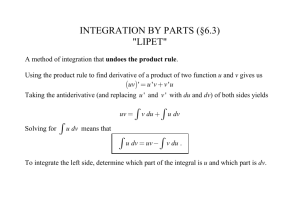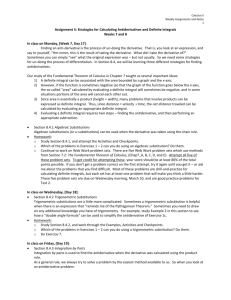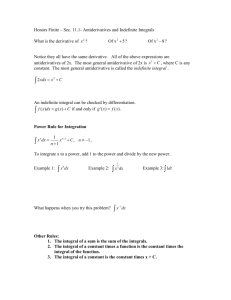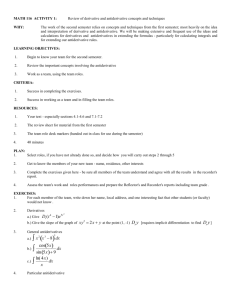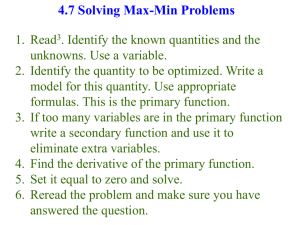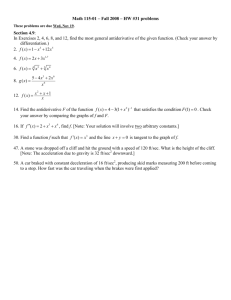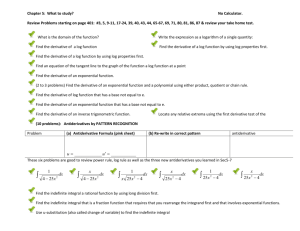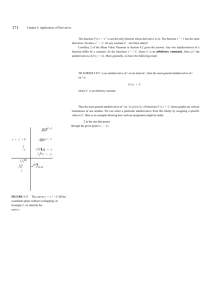Chapter 18A2 & B
advertisement
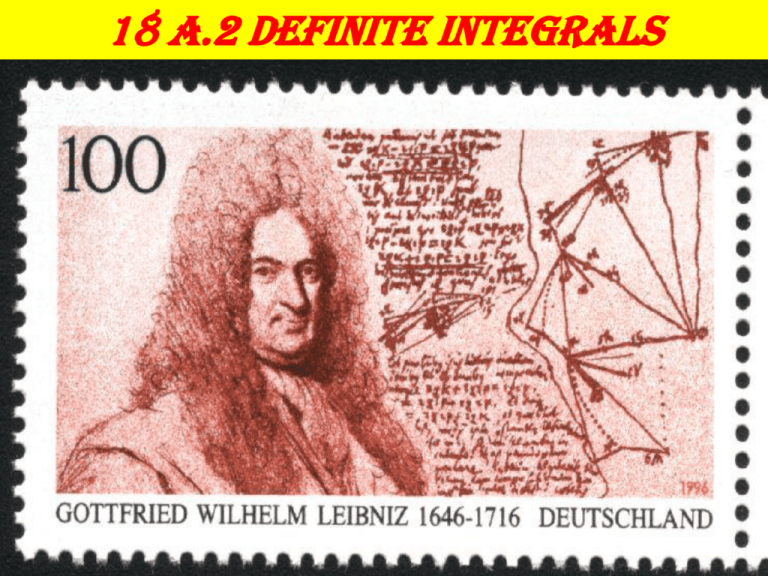
18 A.2 Definite Integrals 3 1 V t2 1 8 When we find the area under a curve by adding rectangles, the answer is called a Riemann sum. 2 1 The width of a rectangle is called a subinterval. 0 1 2 subinterval 3 4 The entire interval is called the partition. partition Subintervals do not all have to be the same size. 3 1 V t2 1 8 If the partition is denoted by P, then the length of the longest subinterval is called the norm of P and is denoted by P . 2 1 0 1 2 3 4 subinterval As P gets smaller, the approximation for the area gets better. This is the Width partition n Area lim f ck xk P 0 k 1 if P is a partition of the interval a, b This is the height n lim f ck xk P 0 is called the definite integral of f over a, b. k 1 If we use subintervals of equal length, then the length of a subinterval is: ba x n The definite integral is then given by: n lim f ck x n k 1 n lim f ck x n k 1 Leibnitz introduced a simpler notation for the definite integral: n b k 1 a lim f ck x f x dx n Note that the very small change in x becomes dx. b a f x dx We have the notation for integration, but we still need to learn how to evaluate the integral. upper limit of integration Integration Symbol f x dx b a integrand lower limit of integration variable of integration (dummy variable) It is called a dummy variable because the answer does not depend on the variable chosen. In Chapter 18 A.1, we considered an object moving at a constant rate of 3 ft/sec. Since rate . time = distance: 3t d If we draw a graph of the velocity, the distance that the object travels is equal to the area under the line. 3 After 4 seconds, the object has gone 12 feet. 2 velocity 1 0 1 2 3 4 ft 3 4 sec 12 ft sec time http://mathworld.wolfram.com/RiemannSum.html Lower Rectangle Sums Upper Rectangle Sums Actual Area: 0.67 Units Squared 5 Using the TI 83/84 for 3 1 Find the area under y 3 x on [1,5] • Graph f(x) • • • • • Press 2nd CALC 7 Enter lower limit 1 Press ENTER Enter upper limit 5 Press ENTER. x dx Set up a Definite Integral for finding the area of the shaded region. Then use geometry to find the area. 2. f x x 1 1. f x 45 6 4 6 4 dx 6 1 4 2 x+1 dx 2 2 5 A bh A (4)(4) 16un b1 b2 A h 2 3 7 2 A 4 20un 2 5 2 Use the limit definition to find 3 1 2 3x dx Graph f(x) y 3x 2 Press 2nd CALC 7 Enter lower limit 1 Press ENTER Enter upper limit 3 Press ENTER. Homework Page 446 Numbers 2 - 3 TITLE PAGE Chapter 18 B Anti - differentiation • A physicist who knows the velocity of a particle might wish to know its position at a given time. • A biologist who knows the rate at which a bacteria population is increasing might want to deduce what the size of the population will be at some future time. • In each case the rate of change (the derivative) is known….but what is the original function? Think About It • Suppose this is the graph of the derivative of a function • What do we know about the original function? – Cubic (y = ax3) – Critical numbers – Where it is increasing, decreasing • What do we not know? f '(x) In this section, we will learn how to determine the original function when given the derivative. We will also learn 21 some applications. Derivatives • Let f(x) = 24x • Some function whose derivative = 24x. • What is it? • Let f(x) = 15x2 • Some function whose derivative = 15x2 • What is it? 22 Derivatives • Let f(x) = 24x3 + 6x. • Some function whose derivative 24x3 + 6x. • What is it? • Let f(x) = e2x • Some function whose derivative = e2x • What is it? 23 Derivatives • Let f(x) = cos(x). • Some function whose derivative = cos(x). • What is it? • Let f(x) = sin(x) • Some function whose derivative = sin(x) • What is it? 24 Derivatives • F(x) is an antiderivative of f(x) • A function F(x) is an antiderivative of a function f(x) • Then F '(x) = 24x = f(x) There is a function, F(x), whose derivative is f(x) • F(x) = 12x2 (Take the derivative of the anti-derivative) 25 Finding An Antiderivative • Given f(x) = 12x3 (This is the derivative. Find the original function) – What is the antiderivative, F(x)? • Use the power rule backwards – Recall that for f(x) = xn … f '(x) = n • x n – 1 – Multiply the expression by the exponent 12 4 F ( x) x 3x 4 – Decrease exponent by 1 4 • Now do opposite (in opposite order) – Increase exponent by 1 – Divide expression by new exponent 26 Anti-Derivatives • Derivatives give us the rate of change of a function • What if we know the rate of change … – Can we find the original function? • If F '(x) = f(x) (This is our Derivative) (Our original function) • F(x) is an antiderivative of f(x) The original function is called the ANTIDERIVATIVE of the rate of change. 27 Antiderivatives • For instance, let f (x) = x2. – It is not difficult to discover an antiderivative of f if we keep the Power Rule in mind. 21 x 2 F ( x) f ( x) x , Find F( x) 2 1 F ( x) x 21 x3 1 3 F ( x) x 3 3 Suppose f x 2x What is its antiderivative? We can make some guesses x 2 2 x 3 2 x 2 x 100000000 2 They all fit! Family of Functions • All of these could “fit” our f(x) = x3. – Their graphs are vertical translates of one another. – This makes sense, as each curve must have the same slope at any given value of x. Antiderivatives • The function G(x) = ⅓ x3 + 100 also satisfies G’(x) = x2. – Therefore, both F and G are antiderivatives of f. • Indeed, any function of the form H(x)=⅓ x3 + C, where C is a constant, is an antiderivative of f. – The question arises: Are there any others? Family of Functions • By assigning “C” to f(x) = x3 + C – Their graphs are vertical translates of one another. – This makes sense, as each curve must have the same slope at any given value of x. Antiderivatives Theorem • If F is an antiderivative of f on an interval I, then the most general antiderivative of f on I is F(x) + C where C is an arbitrary constant. Antiderivatives • Going back to the function f (x) = x2, we see that the general antiderivative of f is ⅓ x3 + C. Indefinite Integrals of Exponential Functions • e x dx e C x kx • e e dx k C kx x • a a dx ln a C x k x • a a dx k ln a C kx 35 Evaluate the definite integral and check the result by differentiation. 12 1 21 x x 2 dx Rewrite: 1 x 2 x dx 1 1 2 Integrate: 12 1 21 x 1x x x 2 dx 3 2 1 2 2 3 2 Simplify: 1 1 2 1 12 1 21 2x 2 x x dx x c 2 3 3 2 Checking 1 12 1 21 2x 2 x x dx x c 2 3 2 3 x 3 2 3 1 2 1 x 2 1 1 2 1 2 1 x x 2 1 2 Homework for 18 B • Page 449 • 1-3 38
